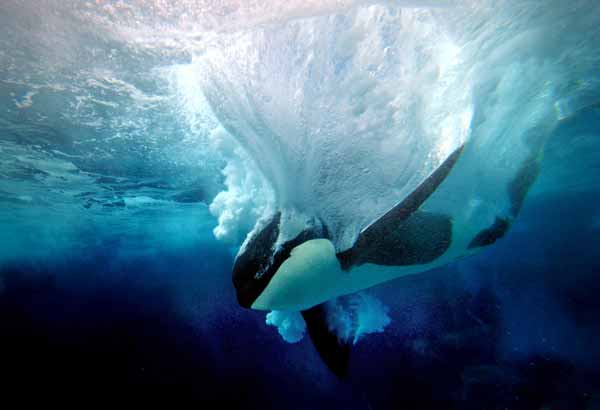Food Preferences & Resources
Killer whales are top-level predators in the ocean. Killer whales are the largest predator of warm-blooded animals alive today.
Globally, killer whales appear to have an extremely diverse diet. Yet, individual ecotypes or populations are often extremely specialized. In many parts of the world, killer whales prey on fishes or marine mammals, but not both.
Worldwide, killer whales have been observed preying on more than 140 species of animals, including many species of bony fish, sharks and rays, and 50 different species of marine mammals.
Killer whales have also been reported to eat many other types of animals including leatherback sea turtles, dugongs, moose, and penguins and other seabirds.

Antarctic small type B killer whales have been observed hunting penguins like these Adélies.
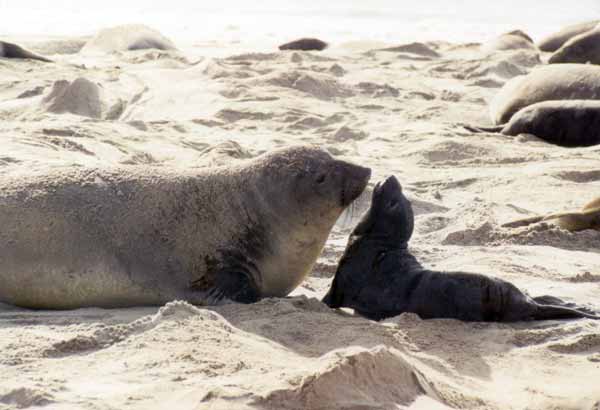
Antarctic type A killer whales have been observed hunting southern elephant seals.
Each killer whale ecotype has a fairly specific diet.
- The five forms of Antarctic killer whales differ in their diet:
- Type A whales eat mostly Antarctic minke whales and have also been observed hunting southern elephant seals.

Minke whales are hunted by the North Atlantic type 2 killer whales in the northern hemisphere
and by the Antarctic type A and large type B ecotypes in the southern hemisphere.
- Large type B whales eat mainly seals, especially Weddell seals, and also hunt minke whales.
- Small type B killer whales have been observed hunting penguins and are believed to mainly eat fishes.
- Type C killer whales mostly eat Antarctic toothfish (Dissostichus mawsoni).
- Little is known about the diet of type D killer whales, however, they have been observed preying on Patagonian toothfish (Dissostichus eleginoides) caught on longlines.
- The feeding habits of resident and transient whales of the eastern North Pacific Ocean differ.
- Resident whales spend about 60% to 65% of daylight hours foraging for fishes. Salmon make up 96% of their diet; Chinook salmon (Oncorhynchus tshawytscha) is the preferred species. Their diet is highly specialized and this dependence may be a limiting factor for this population. To a much lesser degree, residents are also known to eat one species of squid (Gonatopsis borealis) and 22 other species of fish including rockfish (Sebastes spp.), Pacific halibut (Hippoglossus stenolepis) and Pacific herring (Clupea pallasi). There is no evidence of resident killer whales eating marine mammals.
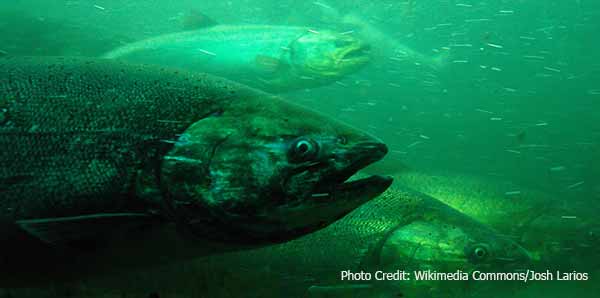
The eastern North Pacific resident killer whales prefer Chinook salmon.
- Transient whales spend about 90% of daylight hours foraging. They primarily eat marine mammals including seals, sea lions, walruses, baleen whales, other toothed whales, and occasionally sea otters.
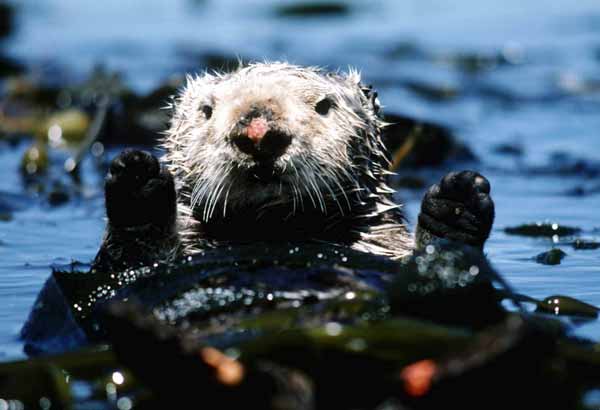
The transient ecotype in the eastern North Pacific hunt marine mammals including sea otters.
- Researchers theorize that the divergent, specialized feeding habits of resident and transient killer whales help prevent these two groups of whales from competing with each other for food.
- Such extremely different feeding habits, which is not known to occur in any other sympatric mammal species, has also resulted in significant differences in vocalizations, echolocation, group size and behavior between the two ecotypes.
- The diet of offshore killer whales in the northeastern Pacific include fishes such as salmon (Oncorhynchus spp.), sculpin (Cottus spp.), Pacific halibut (Hippoglossus stenolepis), and Pacific sleeper sharks (Somniosus pacificus).
- In the North Atlantic, the type 1 killer whales consume a varied diet that includes seals and small, schooling fishes such as herring and mackerel. Type 2 killer whales specialize in cetacean prey including dolphins, porpoises, and baleen whales such as minke whales.
- Although rarely seen, killer whales in Hawaiian waters seem to have a more varied diet including humpback whales, dolphins, octopuses and squids.
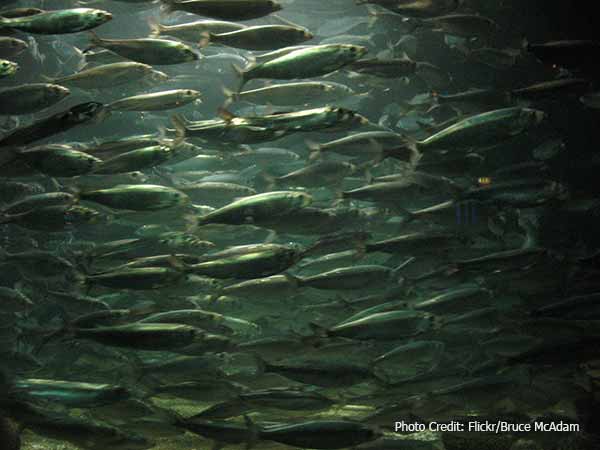
In the North Atlantic, type 1 killer whales hunt schooling fishes such as these herring.

The diet of killer whales in Hawaiian waters includes dolphins..
Food Intake
At SeaWorld parks, adult killer whales eat approximately 1% to 3.5% of their body weight in food per day.
Growing calves eat more — as much as 10% of body weight during growth periods.
- At zoological parks, calves begin to take a few fish at about two to three months.
- A killer whale's lower teeth emerge at about 11 weeks.
- By the age of one year, calves at SeaWorld eat 23 to 27 kg (50 to 60 lbs.) of herring, smelt, and squid per day.
Killer whales don't chew their food. They swallow their food whole, or they may tear or shred it.
Methods of Collecting Food
Killer whales often hunt cooperatively in pods for food.
- Salmon-eating resident killer whales in the North Pacific often pursue prey singularly or in small groups. After a successful kill they regularly (75% of the time) share their fish, usually family members and particularly offspring.
- At times killer whales work together to encircle and herd small prey before attacking. The comparatively large pod size of resident whales is an advantage when herding a school of fish.
- Researchers observed Norwegian killer whales hunting cooperatively using a "carousel-feeding" technique. They cooperatively herded small fishes into a tight ball close to the surface. Then the whales stunned the fishes with their tail flukes and ate the stunned fish.
- To hunt a large baleen whale, a pod of killer whales may attack the whale from several angles. One attack was witnessed by SeaWorld researchers. About 30 killer whales attacked an 18.2 m (60 ft.) blue whale. Two killer whales stayed ahead and two brought up the rear while the others surrounded the blue whale from the sides and underneath in an apparent effort to prevent escape. Some leaped onto its back. The whales took turns biting flesh and blubber from their prey. After five hours the pod broke off the attack.
- Around New Zealand a group of seven killer whales were observed hunting a shortfin mako shark (Isurus oxyrhinchus). As the shark attempted to retreat, it was bitten and held by its tail and then around its girth and head until consumed. Another group of killer whales was filmed attacking a blue shark (Prionace glauca) by striking it hard at the surface of the water with their tail flukes.
- Transient pods are known to "sneak attack" marine mammals. These small groups most often hit quietly or silently. Other observed transient hunting techniques include driving and trapping groups of Pacific white-sided dolphins in confined bays and ramming sea lions with their heads or stunning them with tail fluke swats before taking the animal underwater and drowning it.
- In the Antarctic, individual killer whales slide out onto ice floes to hunt penguins. Similarly, killer whales sometimes slide up onto sand bars or beaches to hunt pinnipeds such as juvenile elephant seals.
- Killer whales sometimes hit ice floes from below to knock penguins and pinnipeds into the water. When an ice floe is too big to be overturned, Antarctic type B killer whales will swiftly swim side-by-side at the ice floe, diving below the floe at the last second, to create a wave large enough to wash a hauled out seal into the water.
- Sometimes killer whales feed in connection with fisheries operations, eating fishes that slip from the nets and bycatch (nontarget fish caught during a fishing operation) discarded by fishermen. In some areas, killer whales congregate near longline boats and feed on the hooked fish.

To hunt a large baleen whale, a pod of killer whales may attack the whale from several angles.
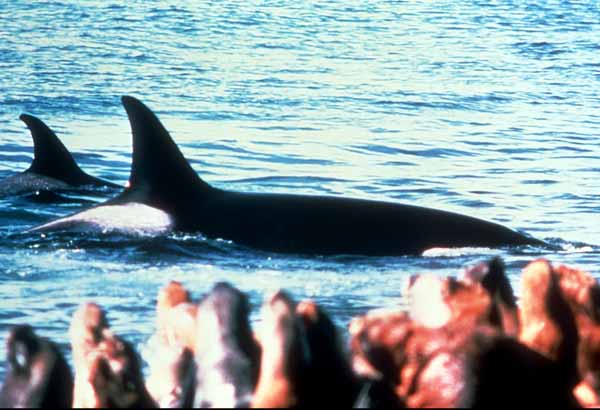
Prey such as these sea lions, may not be safe from killer whales even on land.
Killer whales also hunt individually.
- In the Antarctic, killer whales slide out onto ice floes to hunt penguins. Similarly, killer whales sometimes slide up onto sand bars or beaches to hunt sea lions.
- Killer whales sometimes hit ice floes from below to knock prey into the water.
- An encounter between a great white shark (Carcharodon carcharias) and killer whales was documented off of Southeast Farallon Island near San Francisco, California. shark
- Two killer whales were in the area feeding on a California sea lion (Zalophus californianus) — a favored food of great whites. Perhaps the smell of fresh sea lion blood drew the shark to the area, but once one of the killer whales sighted the great white it immediately charged and contacted the shark under water.
- The killer whale pulled the 3 to 4 m (10 to 13 ft.) shark to the surface in its mouth and the killer whales consumed sections of the great white such as its enormous liver.
- This is certainly no indication of what may happen every time killer whales face great whites, but it does demonstrate the variety of a killer whale's diet.
